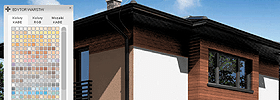PRIMA

Investment white acrylic paint
A dispersion topcoat for white, aesthetic coatings in the interiors of buildings. Especially recommended for painting walls and ceilings in “dry” rooms, utility, warehouse and industrial rooms.
It is used for the initial painting of mineral substrates (such as: concrete, cement plasters, cement-lime, lime and gypsum plasters, and gypsum plasterboards), as well as covered with well set and bound polymer-based coats.
Before applying paint, absorbent or chalking substrates
need to be primed with BUDOGRUNT WG.
| Base binder: | copolymer binder; |
| Pigments: | titanium dioxide white powder; |
| The content of volatile organic compounds VOC: | cat. A / a. The product contains less than 30 g / l VOC; |
| Density: | ca. 1.5 g/cm³; |
| Colours: | white; |
| Gloss level: | deep matt; |
| Diluent: | water; |
| Average coverage: | ca. 0.25 l/m² (with double painting on a smooth substrate); |
| Temperature of application (air and substrate): | from +5°C to +25°C; |
| Relative humidity: | ≤80%; |
| Resistance to wet scrubbing: | paint of class V (per PN-EN 13300) and class II (per PN-C-81914:2002); |
| Packaging: | Single-use plastic packaging of 10 l; |
| Storage: | The product should be stored in its sealed packaging in a cool, but frost-protected room. Keep out of the reach of children; |
| Shelf life: | 12 months from the production date specified on the packaging of the product with originally closed packaging. |
• High substrate coverage
• Resistant to washing
• On mineral substrates and covered with paints
• Favorable price / quality ratio
• For hydrodynamic spraying and manual application
SUBSTRATE PREPARATION: Apply to a sound/stable and clean substrate (without cracks and delaminations), degreased, dry, and free of biological contamination or chemical efflorescence. In the case of fungal growth, the substrate
should be mechanically cleaned and then disinfect with an indoor fungicide. Discolourations, nicotine stains and efflorescences caused by water stains should be painted first with MILAMAT stain blocker. Any loose layers not bound to
the substrate (i.e. loose render or flaked coatings) should be removed. The remnants of adhesive or lime paints should be thoroughly removed and the substrate washed with water. For uneven substrates, first use levelling compound and then level the surface with PROFINISZ ready-to-use finishing compound. Small unevenness can be levelled out at once with PROFINISZ ready-to-use finishing compound. Absorbent substrates should be primed with BUDOGRUNT WG before ready-to-use finishing compound and/or levelling compound application. Fresh cement plasters and cement-lime plasters may be painted after 3-4 weeks of curing period, gypsum plasters after 2 weeks, while the so-called drywall construction can be painted directly after polishing and dust removing.
PRIMING: Prior to paint application, absorbent or dusty (strongly chalking) substrates should be primed with BUDOGRUNT WG. Typical drying time ca. 3 h for the product or base applied on the substrate in optimum conditions (20°C, 55% RH). When primer or base applied on the substrate is completely dry, paint may be applied.
Note: Substrates of low wettability (such as top coats based on polymers or dispersion paint coatings) should not be primed and only washed with water with the addition of CLEANFORCE.
PAINT PREPARATION: If required, add a small amount of primer BUDOGRUNT WG, adding 10% of volume for the first painting.
APPLICATION: Paint should be applied on the substrate in two layers with a brush, roller or by spraying (including also the ‘airless’ method). It is recommended to use a fleece paint roller with a bristle length of 18 mm. The second coat can be applied only after the first one is completely dry.
DRYING: Typical drying time of a single layer of paint applied to the substrate lasts approx. 3 h (with temperature +20°C, 55% RH). After painting, closed rooms should be aired until the specific smell disappears. Note: Drying time may be longer due to low temperatures and high relative humidity. The coating obtains its full mechanical and functional properties after 4 weeks.
USEFUL HINTS: To avoid colour differences it is necessary to make a surface that constitutes a separate architectural whole in one work cycle with material from the same production batch by the “wet on wet” method. During applying and drying the paint the temperature should be up +5°C. After the work finished the tools should be washed with water.


 PRIMA - TDS
PRIMA - TDS